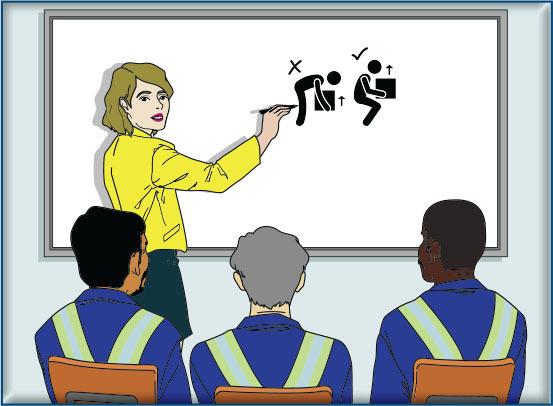Studies show that group support is necessary to instill training.
 What They Did
What They Did
Researchers compared 120 companies that train employees in manual handling (lifting) with similar companies that do not train employees in manual handling.
What They Found
Companies that train their employees in manual handling had the same injury rates as the companies that did not do this training.
There were no differences in:
- sprains and strains
- back injuries
- soft-tissue injuries
- hernias.
Why?
Employees do not take what they learned in the class and apply it when they return to work.

Solution
Training only works when supervisors and coworkers encourage each other to apply the practices taught in the class.
Without this group support, nothing changes.
Talking Points and References
Discussion
Training alone didn't work. What did work?
When a fellow employee saw another employee lifting incorrectly, he or she stopped the employee and suggested trying it the way they learned in the training.
This employee-to-employee exchange works better to lower injury rates than training alone. The number of workplace injuries is more likely to decrease when employees take responsibility for one another.
Report's Conclusion
Researchers looked at 84 research projects on manual handling effectiveness and studied 120 organizations that require manual handling courses
The report concluded that: “There is little evidence that manual handling training, focusing on handling techniques, is effective in promoting safer working practices and reducing manual handling injuries in the workplace.”
Details About Manual Handling Courses
| What didn't matter | Course average |
|---|---|
| Length: It didn't matter if the course was short or long | Average course length was one half-day per year |
| Trainer: It didn't matter if the training was done by an in-house trainer or outside consultant | 75% of companies used their own in-house trainers; 25% used outside consultants |
| Theoretical or Practical: It didn't matter if the training included hands-on practice or used only books or other imagery | Almost 99% of the courses included some practical exercises |
| Quality Ratings: It didn't matter if the course was highly rated by participants or poorly rated | Average quality, as rated by participants, was 55 out of 100; however, there was no association between rated quality and injury rate |
Haslam, C., et al., “Manual Handling Training: Investigation of Current Practices and Development of Guidelines,” Health and Safety Executive, https://www.hse.gov.uk/research/rrpdf/rr583.pdf (2007).
This Safety Minute was prepared by Larkin Communication (www.larkin.biz) in partnership with CEP.
Copyright Permissions
Would you like to reuse content from CEP Magazine? It’s easy to request permission to reuse content. Simply click here to connect instantly to licensing services, where you can choose from a list of options regarding how you would like to reuse the desired content and complete the transaction.
